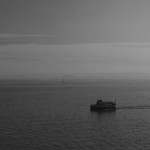I took these shots to test out a Samsung NX1000 converted to full spectrum with a 720nm infrared filter (i.e. the filter lets through all wavelengths above 720nm, and the camera is likely to be sensitive up to around 1000nm). I was using the stock 20-50mm Samsung lens. These photographs cover the “near infrared” range of the spectrum – just beyond the red that our eyes can see, but nowhere near the wavelengths of thermal infrared for things around room temperature.
Properties of IR
Infrared offers some interesting properties when photographing various situations. For example chlorophyll reflects IR very strongly, making all healthy foliage appear bright, while damaged or unhealthy leaves are less reflective (e.g. see the woodland shot). Infrared is also scattered by dust and moisture in the atmosphere much less than shorter wavelengths (this is called Rayleigh scattering and makes the sky or distant hazy things blue). Infrared can see through this haze better than shorter wavelengths, the distant ships off Pendennis point below were barely visible to my eyes through the haze. Spy satellites and aerial photographers often utilise IR because of it ability to cut through haze. These properties also make the sky and water appear eerily/dramatically dark compared to the foliage-covered land, and creates strong definition in clouds.



















Very impressive Material! My converted NX1000 with the standard 20-50 lens shows strong ghost images when using a focal length of 35mm or longer. How did you avoid this problem?
Oh that’s odd. Ghosting is most likely caused by light leaking into the lens from the sides, so try using a lens hood that blocks this out. The lens is also likely to have anti-reflective coatings that don’t work with UV light, causing it to bounce around and cause more ghosting in UV than visible ranges. In which case you’ll probably want to use a different lens for UV work. the only wide-angle lens I’ aware of is the Novoflex Noflexar 35mm.